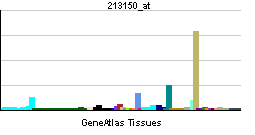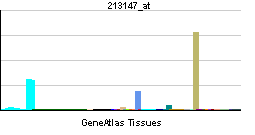Homeobox A10: Difference between revisions
m (Robot: Automated text replacement (-{{WikiDoc Cardiology Network Infobox}} +, -<references /> +{{reflist|2}}, -{{reflist}} +{{reflist|2}})) |
(No difference)
|
Revision as of 18:18, 4 September 2012
| Homeobox A10 | |||||||||||
|---|---|---|---|---|---|---|---|---|---|---|---|
| Identifiers | |||||||||||
| Symbols | HOXA10 ; PL; HOX1; HOX1.8; HOX1H; MGC12859 | ||||||||||
| External IDs | Template:OMIM5 Template:MGI HomoloGene: 7365 | ||||||||||
| |||||||||||
| RNA expression pattern | |||||||||||
 | |||||||||||
 | |||||||||||
| More reference expression data | |||||||||||
| Orthologs | |||||||||||
| Template:GNF Ortholog box | |||||||||||
| Species | Human | Mouse | |||||||||
| Entrez | n/a | n/a | |||||||||
| Ensembl | n/a | n/a | |||||||||
| UniProt | n/a | n/a | |||||||||
| RefSeq (mRNA) | n/a | n/a | |||||||||
| RefSeq (protein) | n/a | n/a | |||||||||
| Location (UCSC) | n/a | n/a | |||||||||
| PubMed search | n/a | n/a | |||||||||
Homeobox A10, also known as HOXA10, is a human gene.[1]
In vertebrates, the genes encoding the class of transcription factors called homeobox genes are found in clusters named A, B, C, and D on four separate chromosomes. Expression of these proteins is spatially and temporally regulated during embryonic development. This gene is part of the A cluster on chromosome 7 and encodes a DNA-binding transcription factor that may regulate gene expression, morphogenesis, and differentiation. More specifically, it may function in fertility, embryo viability, and regulation of hematopoietic lineage commitment. Alternatively spliced transcript variants encoding different isoforms have been described.[1]
See also
References
Further reading
- Eun Kwon H, Taylor HS (2005). "The role of HOX genes in human implantation". Ann. N. Y. Acad. Sci. 1034: 1–18. doi:10.1196/annals.1335.001. PMID 15731295.
- Scott MP (1992). "Vertebrate homeobox gene nomenclature". Cell. 71 (4): 551–3. PMID 1358459.
- Lowney P, Corral J, Detmer K; et al. (1991). "A human Hox 1 homeobox gene exhibits myeloid-specific expression of alternative transcripts in human hematopoietic cells". Nucleic Acids Res. 19 (12): 3443–9. PMID 1676505.
- McAlpine PJ, Shows TB (1990). "Nomenclature for human homeobox genes". Genomics. 7 (3): 460. PMID 1973146.
- Shen WF, Largman C, Lowney P; et al. (1989). "Lineage-restricted expression of homeobox-containing genes in human hematopoietic cell lines". Proc. Natl. Acad. Sci. U.S.A. 86 (21): 8536–40. PMID 2573064.
- Acampora D, D'Esposito M, Faiella A; et al. (1990). "The human HOX gene family". Nucleic Acids Res. 17 (24): 10385–402. PMID 2574852.
- Sauvageau G, Lansdorp PM, Eaves CJ; et al. (1995). "Differential expression of homeobox genes in functionally distinct CD34+ subpopulations of human bone marrow cells". Proc. Natl. Acad. Sci. U.S.A. 91 (25): 12223–7. PMID 7527557.
- Lawrence HJ, Sauvageau G, Ahmadi N; et al. (1995). "Stage- and lineage-specific expression of the HOXA10 homeobox gene in normal and leukemic hematopoietic cells". Exp. Hematol. 23 (11): 1160–6. PMID 7556525.
- Satokata I, Benson G, Maas R (1995). "Sexually dimorphic sterility phenotypes in Hoxa10-deficient mice". Nature. 374 (6521): 460–3. doi:10.1038/374460a0. PMID 7700356.
- Castronovo V, Kusaka M, Chariot A; et al. (1994). "Homeobox genes: potential candidates for the transcriptional control of the transformed and invasive phenotype". Biochem. Pharmacol. 47 (1): 137–43. PMID 7906121.
- Apiou F, Flagiello D, Cillo C; et al. (1996). "Fine mapping of human HOX gene clusters". Cytogenet. Cell Genet. 73 (1–2): 114–5. PMID 8646877.
- Thorsteinsdottir U, Sauvageau G, Hough MR; et al. (1997). "Overexpression of HOXA10 in murine hematopoietic cells perturbs both myeloid and lymphoid differentiation and leads to acute myeloid leukemia". Mol. Cell. Biol. 17 (1): 495–505. PMID 8972230.
- Shen WF, Montgomery JC, Rozenfeld S; et al. (1997). "AbdB-like Hox proteins stabilize DNA binding by the Meis1 homeodomain proteins". Mol. Cell. Biol. 17 (11): 6448–58. PMID 9343407.
- Taylor HS, Vanden Heuvel GB, Igarashi P (1998). "A conserved Hox axis in the mouse and human female reproductive system: late establishment and persistent adult expression of the Hoxa cluster genes". Biol. Reprod. 57 (6): 1338–45. PMID 9408238.
- Taylor HS, Arici A, Olive D, Igarashi P (1998). "HOXA10 is expressed in response to sex steroids at the time of implantation in the human endometrium". J. Clin. Invest. 101 (7): 1379–84. PMID 9525980.
- Kawagoe H, Humphries RK, Blair A; et al. (1999). "Expression of HOX genes, HOX cofactors, and MLL in phenotypically and functionally defined subpopulations of leukemic and normal human hematopoietic cells". Leukemia. 13 (5): 687–98. PMID 10374871.
- Eklund EA, Jalava A, Kakar R (2000). "Tyrosine phosphorylation of HoxA10 decreases DNA binding and transcriptional repression during interferon gamma -induced differentiation of myeloid leukemia cell lines". J. Biol. Chem. 275 (26): 20117–26. doi:10.1074/jbc.M907915199. PMID 10766757.
- Buske C, Feuring-Buske M, Antonchuk J; et al. (2001). "Overexpression of HOXA10 perturbs human lymphomyelopoiesis in vitro and in vivo". Blood. 97 (8): 2286–92. PMID 11290589.
- Cermik D, Karaca M, Taylor HS (2001). "HOXA10 expression is repressed by progesterone in the myometrium: differential tissue-specific regulation of HOX gene expression in the reproductive tract". J. Clin. Endocrinol. Metab. 86 (7): 3387–92. PMID 11443215.
- Shen WF, Krishnan K, Lawrence HJ, Largman C (2001). "The HOX homeodomain proteins block CBP histone acetyltransferase activity". Mol. Cell. Biol. 21 (21): 7509–22. doi:10.1128/MCB.21.21.7509-7522.2001. PMID 11585930.
External links
- HOXA10+protein,+human at the US National Library of Medicine Medical Subject Headings (MeSH)
This article incorporates text from the United States National Library of Medicine, which is in the public domain.
| This protein-related article is a stub. You can help Wikipedia by expanding it. |